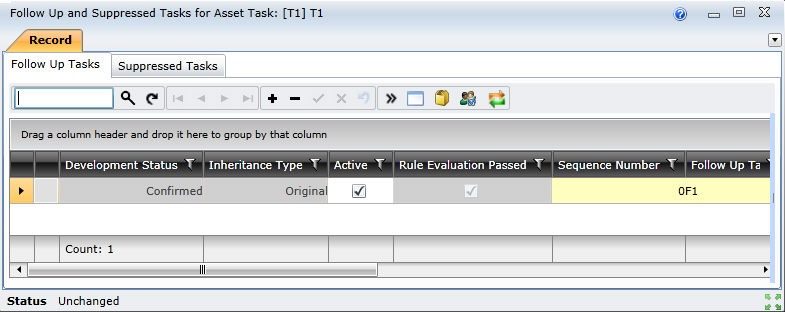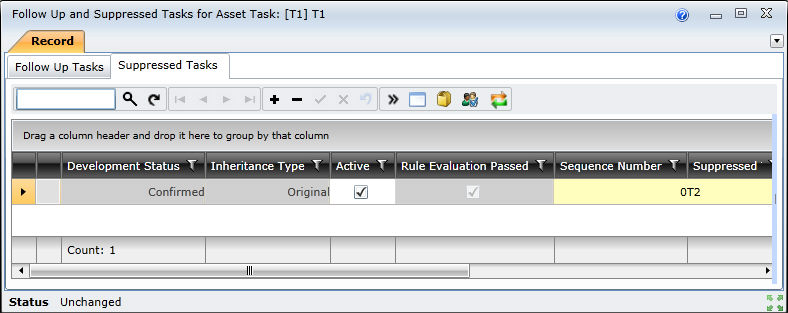
 |

Data fields : Follow Up Task
These data fields are captured or displayed on the Follow Up Tasks for Asset Type Task/Asset Task window.
|
Field |
Description/Setting |
|
Development Status |
The development status of the Task’s Follow Up Task item. |
|
Inheritance Type |
The Inheritance Type indicates how the Task’s Follow Up Task item came into existence. Possible values are “Original” or “Inherited”. |
|
Active |
Ticked if the Task is active. |
|
Rule Evaluation Passed |
Ticked if the rule evaluation for the Asset Task’s Follow Up Task was successful. |
|
Sequence number |
The sequence in which the Follow Up Tasks must be executed. |
|
Follow Up Task Code |
The Task Code that identifies the Follow Up Task. Select the code from the Follow Up Tasks lookup list for this Asset Type or Asset. The Task Description is displayed. |
|
Add to Work Order |
Ticked if the Task must be added to the Work Order. |
|
Trigger when Failed |
Only if the Component is not linked to a Monitoring Point and Inspection is ticked on the Task - Details tab. Ticked if the Follow Up Task is generated when Work Order feedback result for the Task is “Failed”. |
|
Trigger when Upper Critical Exceeded |
Only if the Component is linked to a Monitoring Point. Ticked if an Alarm is generated when this condition is met. |
|
Trigger when Upper Warning Exceeded |
Only if the Component is linked to a Monitoring Point. Ticked if the Task is generated when this condition is met. |
|
Trigger when Lower Warning Exceeded |
Only if the Component is linked to a Monitoring Point. Ticked if the Task is generated when this condition is met. |
|
Trigger when Lower Critical Exceeded |
Only if the Component is linked to a Monitoring Point. Ticked if the Task is generated when this condition is met. |
|
Follow Up Task Active |
Ticked if the ancestor Task for this Task is active in the Asset Type Tree. |
|
Follow Up Task Asset Type / Asset path |
The path to the Component to which the Task and its Follow Up Task is linked in the Asset Type Tree or Asset Tree. |
|
Follow Up Task Component path |
The path to the Component to which the Task and its Follow Up Task is linked in the Asset Type Tree or Asset Tree. |
Please note!
The Follow Up Task must be added to the Component or Asset before it is linked to another Task for the same Component, Asset Type or Asset.
More information

Data fields
These data fields are displayed on the Suppressed Tasks for Asset Type Task/Asset Task window.
|
Field |
Description/Setting |
|
Development Status |
The development status of the Task’s Suppressed Task item. |
|
Active |
Ticked if the Asset Task is active. |
|
Inheritance Type |
The Inheritance Type indicates how the Task's Suppressed Task item came into existence and its current configuration. |
|
Sequence Number |
The sequence in which the Supressed Task must be performed. For example, “1” or “2” or “5”. |
|
Suppressed Task Code |
The Task Code that identifies an Asset Task that is suppressed by the current Asset Task. Select the code from the Tasks lookup list for this Asset Type or Asset. The Task Description is displayed. May not be changed if the item is inherited. |
|
Number of Cycles Suppressed |
The number of times after the current occurrence that the Asset Task must be suppressed (not generated) when generating Proposed Work Orders. Num Cycles Suppressed accepts decimal places so that fractional suppression cycles can be used. Set to “0” if every occurrence of the Asset Task is suppressed. |
|
Suppression Percentage |
The Asset Task must be suppressed (not included) when generating Proposed Work Orders if its Estimated Next Due Date falls within the number of days determined by (Default Interval * Suppression %) before or after the current Task's Estimated Next Due Date. For example, if the suppressed Asset Task's Suppression % is 50% and its Default Interval (scheduling frequency) is “7” days then the suppressed Asset Task is not scheduled if its Estimated Next Due Date is within “3.5” days (before and after) the current Asset Task's Estimated Next Due Date. |
|
Suppress Days From |
Suppress this Asset Task if its Estimated Next Due Date is within this number of days before the date on which the current Asset Task is due to start i.e. before the current Asset Task's Estimated Next Due Date. For example, the suppressed Asset Task falls due every Monday, and the current Asset Task falls due on a Wednesday once a month. If Suppress Days From is set to “2” days for the suppressed Asset Task then it is suppressed (not scheduled) when its Estimated Next Due Date is within “2” days before the current Asset Task's Estimated Next Due Date. |
|
Suppress Days To |
Suppress this Asset Task if its Estimated Next Due Date is within this number of days after the date on which the current Asset Task is due to start i.e. after the current Asset Task's Estimated Next Due Date. For example, the suppressed Asset Task falls due every Thursday, and the current Asset Task falls due on a Wednesday once a month. If Suppress Days From is set to “2” days for the suppressed Asset Task then it is suppressed (not scheduled) when its Estimated Next Due Date is within “2” days after the current Asset Task's Estimated Next Due Date. |
|
Suppressed Task Active |
Ticked if the Asset Task that the current Asset Task originated from is active in the Asset Type Tree. |
|
Suppressed Task Asset Type Path |
Only for an Asset Type Task. The path in the Asset Type Tree to the Component to which this Task is added. |
|
Suppressed Task Asset Path |
Only for an Asset Task. The path in the Asset Tree to the Component to which this Task is added. |
|
Suppressed Task Component Path |
The Component to which this Task is added.
|
Please note!
More information